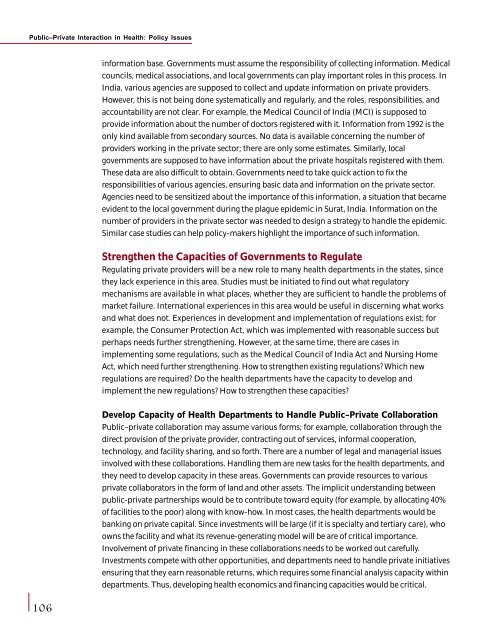Health Policy Issues and Health Programmes in ... - Amazon S3
Health Policy Issues and Health Programmes in ... - Amazon S3
Health Policy Issues and Health Programmes in ... - Amazon S3
- No tags were found...
Create successful ePaper yourself
Turn your PDF publications into a flip-book with our unique Google optimized e-Paper software.
Public–Private Interaction <strong>in</strong> <strong>Health</strong>: <strong>Policy</strong> <strong>Issues</strong><strong>in</strong>formation base. Governments must assume the responsibility of collect<strong>in</strong>g <strong>in</strong>formation. Medicalcouncils, medical associations, <strong>and</strong> local governments can play important roles <strong>in</strong> this process. InIndia, various agencies are supposed to collect <strong>and</strong> update <strong>in</strong>formation on private providers.However, this is not be<strong>in</strong>g done systematically <strong>and</strong> regularly, <strong>and</strong> the roles, responsibilities, <strong>and</strong>accountability are not clear. For example, the Medical Council of India (MCI) is supposed toprovide <strong>in</strong>formation about the number of doctors registered with it. Information from 1992 is theonly k<strong>in</strong>d available from secondary sources. No data is available concern<strong>in</strong>g the number ofproviders work<strong>in</strong>g <strong>in</strong> the private sector; there are only some estimates. Similarly, localgovernments are supposed to have <strong>in</strong>formation about the private hospitals registered with them.These data are also difficult to obta<strong>in</strong>. Governments need to take quick action to fix theresponsibilities of various agencies, ensur<strong>in</strong>g basic data <strong>and</strong> <strong>in</strong>formation on the private sector.Agencies need to be sensitized about the importance of this <strong>in</strong>formation, a situation that becameevident to the local government dur<strong>in</strong>g the plague epidemic <strong>in</strong> Surat, India. Information on thenumber of providers <strong>in</strong> the private sector was needed to design a strategy to h<strong>and</strong>le the epidemic.Similar case studies can help policy-makers highlight the importance of such <strong>in</strong>formation.Strengthen the Capacities of Governments to RegulateRegulat<strong>in</strong>g private providers will be a new role to many health departments <strong>in</strong> the states, s<strong>in</strong>cethey lack experience <strong>in</strong> this area. Studies must be <strong>in</strong>itiated to f<strong>in</strong>d out what regulatorymechanisms are available <strong>in</strong> what places, whether they are sufficient to h<strong>and</strong>le the problems ofmarket failure. International experiences <strong>in</strong> this area would be useful <strong>in</strong> discern<strong>in</strong>g what works<strong>and</strong> what does not. Experiences <strong>in</strong> development <strong>and</strong> implementation of regulations exist; forexample, the Consumer Protection Act, which was implemented with reasonable success butperhaps needs further strengthen<strong>in</strong>g. However, at the same time, there are cases <strong>in</strong>implement<strong>in</strong>g some regulations, such as the Medical Council of India Act <strong>and</strong> Nurs<strong>in</strong>g HomeAct, which need further strengthen<strong>in</strong>g. How to strengthen exist<strong>in</strong>g regulations? Which newregulations are required? Do the health departments have the capacity to develop <strong>and</strong>implement the new regulations? How to strengthen these capacities?106Develop Capacity of <strong>Health</strong> Departments to H<strong>and</strong>le Public–Private CollaborationPublic–private collaboration may assume various forms; for example, collaboration through thedirect provision of the private provider, contract<strong>in</strong>g out of services, <strong>in</strong>formal cooperation,technology, <strong>and</strong> facility shar<strong>in</strong>g, <strong>and</strong> so forth. There are a number of legal <strong>and</strong> managerial issues<strong>in</strong>volved with these collaborations. H<strong>and</strong>l<strong>in</strong>g them are new tasks for the health departments, <strong>and</strong>they need to develop capacity <strong>in</strong> these areas. Governments can provide resources to variousprivate collaborators <strong>in</strong> the form of l<strong>and</strong> <strong>and</strong> other assets. The implicit underst<strong>and</strong><strong>in</strong>g betweenpublic-private partnerships would be to contribute toward equity (for example, by allocat<strong>in</strong>g 40%of facilities to the poor) along with know-how. In most cases, the health departments would bebank<strong>in</strong>g on private capital. S<strong>in</strong>ce <strong>in</strong>vestments will be large (if it is specialty <strong>and</strong> tertiary care), whoowns the facility <strong>and</strong> what its revenue-generat<strong>in</strong>g model will be are of critical importance.Involvement of private f<strong>in</strong>anc<strong>in</strong>g <strong>in</strong> these collaborations needs to be worked out carefully.Investments compete with other opportunities, <strong>and</strong> departments need to h<strong>and</strong>le private <strong>in</strong>itiativesensur<strong>in</strong>g that they earn reasonable returns, which requires some f<strong>in</strong>ancial analysis capacity with<strong>in</strong>departments. Thus, develop<strong>in</strong>g health economics <strong>and</strong> f<strong>in</strong>anc<strong>in</strong>g capacities would be critical.







